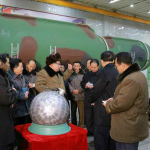Five Things You Need to Know about Kim Jong Un’s Photo Op with the Bomb

On March 9, KCNA and Rodong Sinmun announced that Kim Jong Un had visited a facility where he learned about North Korea’s progress in mating nuclear weapons to ballistic missiles. A subsequent television broadcast included more than dozen still images from the visit. Not only did Kim Jong Un pose with a number of missiles, including the KN-08, but he also posed with a model of compact nuclear weapon and modern reentry body.
Here are the five things you need to know about Kim’s visit.
- Kim might have been visiting the Chamjin Missile Factory outside of Pyongyang.
North Korea did not announce the location of the visit, but a likely location is the North’s main missile production facility outside of Pyongyang, the Tae-sung Machine Factory (also known as the Chamjin Missile Factory). Michael Madden has matched the ceiling lights to the lone picture believed to have been taken at the site. The Tae-sung Machine Factory is located at: 38.951517°N, 125.568482°E.
- The room is filled with a number of North Korean ballistic missiles.
Although attention has understandably focused on the nuclear weapon sitting in front of Kim, the factory room contains two known modifications of the KN-08, unpainted Nodong missiles and what may be Musudan missiles. While most of the press reporting has focused on North Korea’s ICBM, the official announcement said that the North’s nuclear warheads “have been standardized to be fit for ballistic rockets by miniaturizing them.” That, along with the variety of missiles in the room, suggests North Korea plans to arm several types of missiles with nuclear warheads.
- We know a lot more about the KN-08, including that it uses two Nodong engines.
Since North Korea displayed the KN-08 ICBM during parades in 2012 and 2013, followed by a substantially modified version in 2015, analysts have attempted to estimate the missile’s design and performance. In 2013, John Schilling argued that the first stage of the KN-08 was most likely a pair of Nodong engines. Although the images do not provide quite enough detail to determine the type of engine, for the first time we can confirm that the first stage of the KN-08 Mod 1 comprises two engines. That increases our confidence in our estimates of the KN-08’s range and payload. The fact that both missiles are displayed, along with an analysis of the serial numbers, suggests that North Korea intends to deploy both variants of the KN-08.
- North Korea has a more plausible reentry body.
One of the big questions about North Korea’s nuclear program is whether or not North Korea can design a reentry vehicle that will protect the warhead during its journey from launch to target. The KN-08 missiles that North Korea paraded in 2012 and 2013 were almost certainly mock-ups. Although the quality of the mock-ups improved between parades, the nosecones were particularly unconvincing. North Korea has now shown a reentry body that looks like early US and Soviet ones. The reentry body still hasn’t been tested, but this is the first credible reentry vehicle design that North Korea has displayed.
- The nuclear weapon—a compact fission device—would be small enough for a missile.
There has long been a debate about whether to take the DPRK’s claims to have “miniaturized” its nuclear weapons seriously. As I have argued previously, there is enough open source evidence to take seriously the possibility that North Korea has developed a compact fission device that is approximately 60 cm in diameter and weighs between 200-300 kilograms. It is hard to make precise measurements at this size, but we assume the warheads fit inside the reentry body next to it. This would be similar to a Pakistani nuclear design that surfaced in Switzerland after the break-up of the A.Q. Khan network. The size of the object is consistent with these expectations. The device is not a classical two-stage thermonuclear weapon, but North Korean designers may use deuterium-tritium gas to “boost” the yield of the nuclear explosion. The object is probably a mockup, since nuclear weapons are filled with conventional explosives and would be very dangerous. Some US experts are skeptical—they don’t think the object looks right. It does not look like US devices, to be sure, but it is hard to know if aspects of the model are truly implausible or simply that North Korean nuclear weapons look different than their Soviet and American cousins. The size, however, is consistent with my expectations for North Korea. And it is hard to believe that, after four nuclear tests, the North Koreans can’t make a plausible mock-up.
Kim Jong Un’s decision to pose with a nuclear weapon is not surprising. For several years now, North Korean officials have asserted that they have the capability to strike targets in the United States. North Korea has paraded variants of the KN-08 ICBM on three occasions, announced that previous nuclear tests were for the purpose of “miniaturizing” the North’s nuclear weapons, and published a map of the targets in the United States including Washington, DC. In response to these threats, US officials have consistently stated that North Korea has yet to demonstrate the full range of technologies necessary to target the United States. The images released on March 9 are intended to bolster the North’s deterrent in the face of such skepticism.
Jeffrey Lewis is Director of the East Asia Nonproliferation Program at the James Martin Center for Nonproliferation Studies (CNS), Middlebury Institute of International Studies at Monterey, and a frequent contributor to 38 North.
